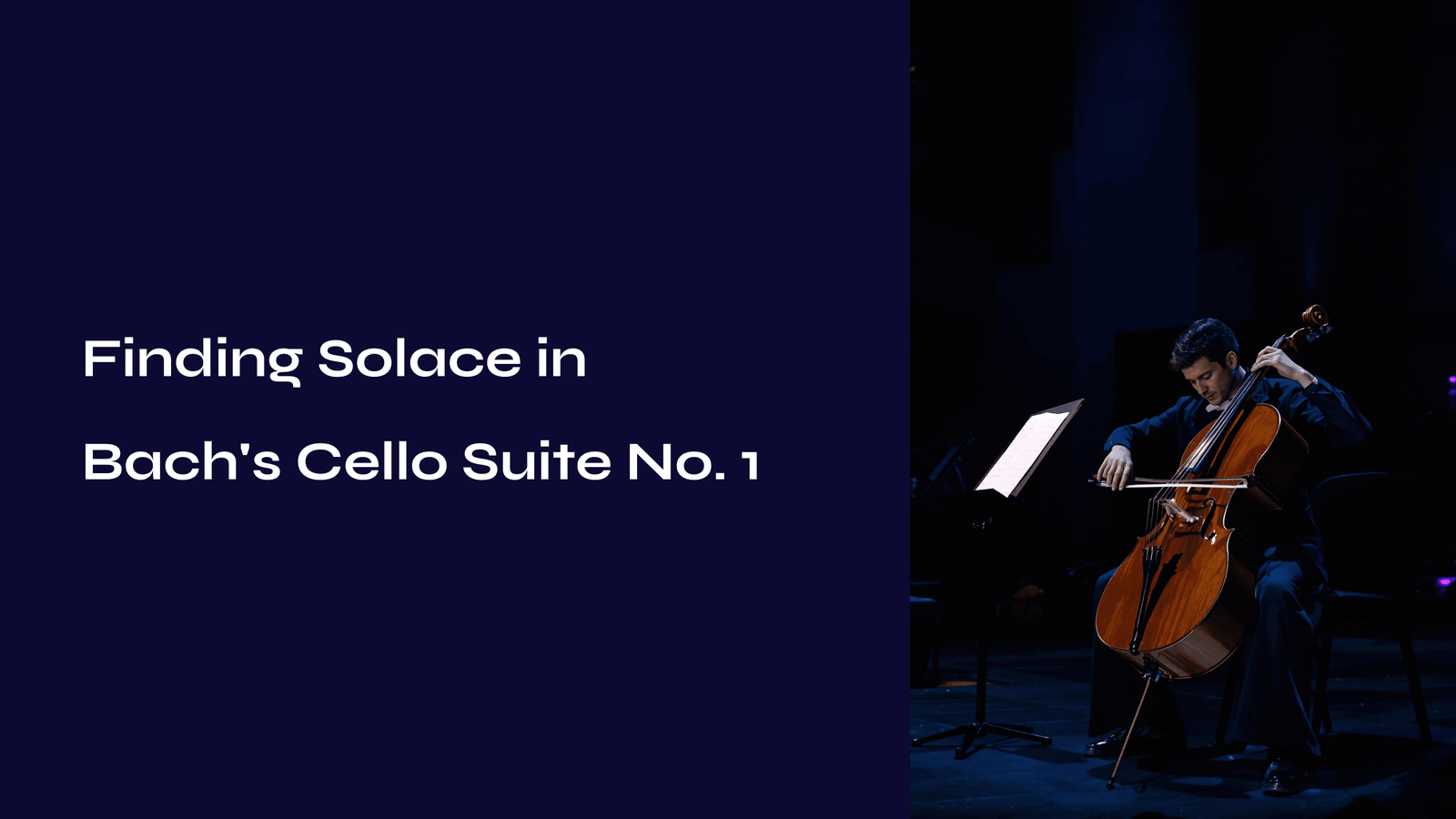Table of Contents
The first time I heard Bach’s Cello Suite No. 1, I was sitting in a dim concert hall, completely unprepared for how those opening notes would affect me. As the cellist drew their bow across the strings and those first arpeggios floated through the air, something shifted inside me. Time seemed to slow, and for just a few minutes, the world outside ceased to exist. There was only the music—pure, transparent, and somehow both simple and infinitely complex. I’ve returned to this piece countless times since then, finding it offers something new with each listening, like an old friend who still keeps secrets.

The Genius Behind the Suite: Bach’s Golden Period
Johann Sebastian Bach composed his six cello suites between 1717 and 1723 during what many consider his most fertile creative period. As Kapellmeister in Köthen under the patronage of Prince Leopold, Bach found himself in a unique position. Unlike his previous and later positions that demanded religious music, his role at Köthen allowed him to focus almost exclusively on instrumental compositions.
During this remarkably productive time, Bach also created his “Brandenburg Concertos,” the first part of the “Well-Tempered Clavier,” and numerous other instrumental works that would come to define Western classical music. The cello suites were titled “Suites à Violoncello Solo senza Basso” (Suites for cello solo without bass)—an unusually minimalist approach for the Baroque period when continuo accompaniment was standard practice.
Interestingly, Bach’s original manuscript of these suites has been lost to history. What we have instead is a copy made by his second wife, Anna Magdalena Bach. This historical quirk has left performers with significant interpretive freedom, as her notation of slurs and other expressive markings appears inconsistent, leaving musicians to make crucial decisions about how the music should be articulated and phrased.

The Architecture of Beauty: Inside the G Major Prélude
The Prélude that opens Suite No. 1 flows like a gentle stream in its steady sixteenth notes, all in a 4/4 time signature. From the first measure, Bach establishes a radiant G major tonality that feels at once welcoming and profound. The movement begins with a clear statement of the G major chord (G, D, B), which serves as a musical seed from which the entire suite grows.
If we look at the architecture of this movement, we can divide it into two main sections:
The Opening Journey (measures 1-22)
The Prélude begins firmly in G major, with Bach employing a pedal point on G that creates a sense of grounding and stability. The first four measures establish a pattern of arpeggiated chords that feels almost improvisatory, like a musician testing the waters before diving deeper. Bach then gradually introduces more tension, ultimately moving toward the dominant key of D major.
The Return Home (measures 22-42)
In the second section, Bach employs more scale passages and introduces pedal points on different notes (A and D), creating contrasts with the opening section. What makes this part so satisfying is how it builds tension through harmonic exploration before finally returning to the home key of G major, creating a sense of resolution and completion.
What’s fascinating about this piece is how Bach balances mathematical precision with emotional expression. Every note serves a purpose in the harmonic progression, yet the overall effect is one of natural, organic flow rather than rigid construction. This is Bach’s supreme gift—creating music that satisfies both the intellect and the heart simultaneously.

From Forgotten Exercise to Beloved Masterpiece
Perhaps the most remarkable aspect of Bach’s cello suites is that for nearly two centuries, they were largely forgotten by the musical public. Most cellists knew them only as technical exercises rather than profound musical works worthy of the concert stage.
This changed dramatically thanks to a 13-year-old Spanish cellist named Pablo Casals. In 1890, while browsing a second-hand music shop in Barcelona, young Casals discovered an 1866 edition of these suites edited by Friedrich Grützmacher. Something about the music captivated him, and he spent the next twelve years privately studying the suites before performing them publicly.
When Casals finally recorded the suites between 1936 and 1939, he transformed their status in the musical world. What had been considered mere technical studies suddenly revealed themselves as profound artistic statements. Today, it’s almost impossible to imagine the cello repertoire without these works at its center.

My Personal Connection: Finding Meaning in Bach’s Patterns
I’ve found that my relationship with this music has evolved over the years. At first, I was simply captivated by the flowing beauty of the Prélude—its accessibility makes it an ideal entry point for anyone new to classical music. But with repeated listenings, I began to appreciate the mathematical elegance hiding beneath the surface.
There’s something almost meditative about how Bach creates patterns that simultaneously satisfy logical expectations while introducing enough variation to keep the ear engaged. In today’s chaotic world, I find myself returning to this music as a reminder that order and beauty can coexist—that structure needn’t feel constraining but can instead provide a framework for profound expression.
What I find most moving is how Bach achieves so much with so little. Using just a single cello—no accompaniment, no flashy virtuosity—he creates a complete musical world. There’s a lesson there about the power of simplicity and the depth that can be found when we strip away everything unnecessary.

Listening Guide: How to Deepen Your Experience
If you’re approaching Bach’s Cello Suite No. 1 for the first time—or even returning to it after many listenings—here are some suggestions to enhance your experience:
- Listen for the pedal tones: Notice how Bach frequently returns to open G string notes, creating a sense of grounding throughout the piece. When this anchor temporarily disappears in the middle section, its eventual return creates a powerful feeling of homecoming.
- Follow the harmonic journey: Even without formal music training, you can feel the piece move from stability to tension and back again. Pay attention to how your emotional response shifts as the harmonies change.
- Compare different interpretations: Try listening to recordings by several cellists—Yo-Yo Ma, Mstislav Rostropovich, Pablo Casals, and Jacqueline du Pré all bring unique perspectives to this music. Some take a more romantic approach with dramatic dynamics, while others opt for a lighter, more historically informed performance style.
- Notice the breathing points: Though written for a string instrument, the music contains natural phrases that feel almost vocal. Notice where these musical “sentences” begin and end, and how Bach creates natural breathing spaces.
- Listen to the entire suite: While the Prélude is justifiably famous, it’s just the first movement of a six-movement suite. Each subsequent dance movement (Allemande, Courante, Sarabande, Minuets, and Gigue) explores different facets of G major’s character and offers a complete emotional journey when heard together.

The Timeless Voice That Speaks to All
Three hundred years after its composition, Bach’s G Major Cello Suite continues to move listeners across generations and cultures. Legendary cellist Yo-Yo Ma has performed these suites throughout his career, describing them as his “constant musical companions” that have provided “sustenance, comfort, and joy during times of stress, celebration, and loss.”
What makes this music endure is its remarkable balance of accessibility and depth. A first-time listener can be captivated by its beauty, while musicians can spend a lifetime exploring its intricacies. As Ma observed, Bach was a “musician-scientist, expressing precise observations about nature and human nature” in these works.
In our fragmented modern world, where attention spans shorten and noise surrounds us, Bach’s Cello Suite No. 1 offers a rare opportunity for contemplation and connection. Its journey from forgotten exercise to beloved masterpiece reminds us that true artistic value may not always be immediately recognized, but genuine beauty has a way of eventually finding its audience.
The next time you have four minutes to spare, I invite you to close your eyes and listen to the Prélude. Allow yourself to be carried by those flowing sixteenth notes, and perhaps you too will find what so many others have discovered in this music—a perfect marriage of intellect and emotion, a musical voice that somehow speaks directly to what it means to be human.
If You Loved This, Listen to This Next
If you were moved by the meditative beauty of Bach’s Cello Suite No. 1, you might find yourself equally enchanted by Cimarosa’s Oboe Concerto (A Melody Adorning the Silent Night) – where the oboe’s elegant voice weaves through the orchestra with a clarity and emotional depth reminiscent of Bach’s solo cello writing.



